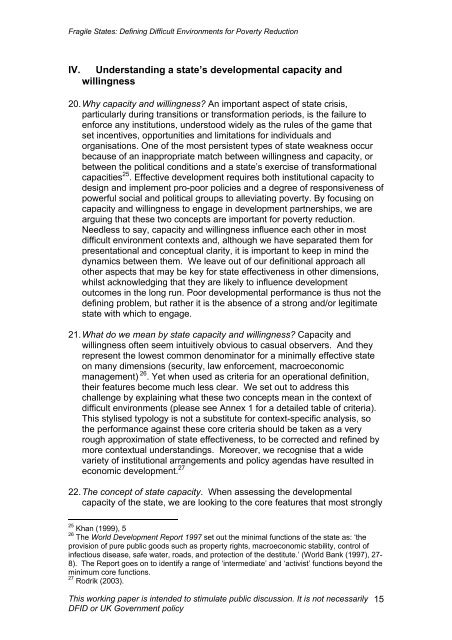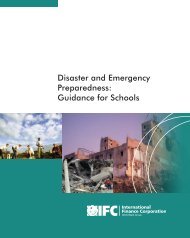Fragile States: Defining Difficult Environments for Poverty ... - INEE
Fragile States: Defining Difficult Environments for Poverty ... - INEE
Fragile States: Defining Difficult Environments for Poverty ... - INEE
You also want an ePaper? Increase the reach of your titles
YUMPU automatically turns print PDFs into web optimized ePapers that Google loves.
<strong>Fragile</strong> <strong>States</strong>: <strong>Defining</strong> <strong>Difficult</strong> <strong>Environments</strong> <strong>for</strong> <strong>Poverty</strong> ReductionIV. Understanding a state’s developmental capacity andwillingness20. Why capacity and willingness? An important aspect of state crisis,particularly during transitions or trans<strong>for</strong>mation periods, is the failure toen<strong>for</strong>ce any institutions, understood widely as the rules of the game thatset incentives, opportunities and limitations <strong>for</strong> individuals andorganisations. One of the most persistent types of state weakness occurbecause of an inappropriate match between willingness and capacity, orbetween the political conditions and a state’s exercise of trans<strong>for</strong>mationalcapacities 25 . Effective development requires both institutional capacity todesign and implement pro-poor policies and a degree of responsiveness ofpowerful social and political groups to alleviating poverty. By focusing oncapacity and willingness to engage in development partnerships, we arearguing that these two concepts are important <strong>for</strong> poverty reduction.Needless to say, capacity and willingness influence each other in mostdifficult environment contexts and, although we have separated them <strong>for</strong>presentational and conceptual clarity, it is important to keep in mind thedynamics between them. We leave out of our definitional approach allother aspects that may be key <strong>for</strong> state effectiveness in other dimensions,whilst acknowledging that they are likely to influence developmentoutcomes in the long run. Poor developmental per<strong>for</strong>mance is thus not thedefining problem, but rather it is the absence of a strong and/or legitimatestate with which to engage.21. What do we mean by state capacity and willingness? Capacity andwillingness often seem intuitively obvious to casual observers. And theyrepresent the lowest common denominator <strong>for</strong> a minimally effective stateon many dimensions (security, law en<strong>for</strong>cement, macroeconomicmanagement) 26 . Yet when used as criteria <strong>for</strong> an operational definition,their features become much less clear. We set out to address thischallenge by explaining what these two concepts mean in the context ofdifficult environments (please see Annex 1 <strong>for</strong> a detailed table of criteria).This stylised typology is not a substitute <strong>for</strong> context-specific analysis, sothe per<strong>for</strong>mance against these core criteria should be taken as a veryrough approximation of state effectiveness, to be corrected and refined bymore contextual understandings. Moreover, we recognise that a widevariety of institutional arrangements and policy agendas have resulted ineconomic development. 2722. The concept of state capacity. When assessing the developmentalcapacity of the state, we are looking to the core features that most strongly25 Khan (1999), 526 The World Development Report 1997 set out the minimal functions of the state as: ‘theprovision of pure public goods such as property rights, macroeconomic stability, control ofinfectious disease, safe water, roads, and protection of the destitute.’ (World Bank (1997), 27-8). The Report goes on to identify a range of ‘intermediate’ and ‘activist’ functions beyond theminimum core functions.27 Rodrik (2003).This working paper is intended to stimulate public discussion. It is not necessarilyDFID or UK Government policy15
















